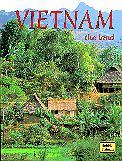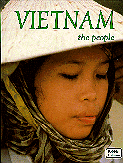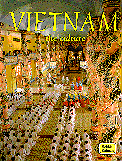


|
Vietnam: The Land. Vietnam: The People. Vietnam: The Culture.
Bobbie Kalman.
The Land ISBN 0-86505-223-9 cloth, 0-86505-303-0 paper. Subject Heading: Subject Heading: Subject Heading:
Grades 4 - 6 / Ages 9 - 11. *** /4
|

Vietnam is the latest country added to the highly successful Lands, Peoples and Cultures Series developed by Bobbie Kalman. Generally the series has one book each for the land, the people and the culture of each country, and previous countries featured include Canada, Mexico, China and Japan.
In the Vietnam books, the reading level is appropriate for
elementary aged students (although the publisher recommends elementary and junior high)
and the writing style is relaxed and informative. The emphasis is more on
an introduction to the topics covered rather than an in-depth portrait.
The books are well-designed. The full-colour photographs are of
exceptional quality and comprise more than fifty percent of each book, and they are
well-chosen and well-placed. There is a table of contents with appropriate
titles (not cute or puzzling), consistent pagination, a comprehensive
glossary, and a subject index.
excerpt:
Vietnam is a long, narrow country stretching along the east coast of the Indochinese Peninsula in Southeast Asia. The Vietnamese say their country is shaped like a bent bamboo pole carrying a rice basket at each end. If you look at the map, you will see that Vietnam has an S shape ,wide at the top and bottom and very narrow at the center. The country is divided into three geographic regions: the north, center, and south.
Vietnam: The Land covers its geography, climate, agriculture, fishery, transportation, wildlife, cities and a little history. My only quibble with this book is the lack of maps. The first page gives a locational map of Vietnam's place in Southeast Asia, which is good, but the only other map is a rather small physical map with some place names.
 excerpt:
excerpt:
With so many children to educate and so little money, schools often cannot afford supplies. Some classrooms have little else than old wooden benches, scratched tables, and fifty determined students. Children go to school six days a week. Many must walk a long distance. In crowded schools, the students work in shifts so that all the children in the community can get an education. One group of students goes to school early in the morning, perhaps from 7:30 to 11:30. Then a second group comes to school in the afternoon. Often there is a long break for lunch because the weather gets very hot. People usually take a nap after lunch. Schools located in farming areas schedule long vacations for harvest time. Students spend their holiday helping on the farm! Young people who work on the family farm or become laborers often cannot continue their education beyond primary school.
Vietnam: the People covers the different ethnic makeup of the Vietnamese, the importance of family, the difference between rural and urban living conditions, and the language, education, occupations and leisure of modern Vietnamese.
Care has been taken to include information of interest to
elementary children, and that provides a basis for comparison with their
own lives. For example, in the excerpt directly above, the school situation
is very different from contemporary western schools. North American
children will also be intrigued by the practice of shopping at markets
rather than department stores with fixed prices, and by the domestic
arrangements, leisure activities and career expectations of young
Vietnamese.
 excerpt:
excerpt:
In North America, many people think of puppets as toys for children but, in Vietnam, puppetry is enjoyed by young and old. This theatre art has been popular for centuries. Puppetmakers and puppeteers are skilled and respected artists who spend years perfecting their talents. One popular form of puppetry is called roi nuoc, or water puppetry. Water puppetry is unique because its "stage" is a small pond. It is said that this art was invented centuries ago when an ordinary puppet show was interrupted by one of Vietnam's many floods! From behind a backdrop, puppeteers move strings, wires, and bamboo poles to make the wooden puppets glide around on the water. The audience, sitting on the shore, often laughs at their funny tales and antics.
Vietnam: the Culture describes the arts, fashion, food, religion and festivals. The historical influences of Chinese, French, and even American people during the Vietnam war are noted in the introduction and referred to specifically throughout the text. Although the major influence appears to be Chinese, the erosion of traditional customs and the adoption of more western practices is evident.
Altogether, the three books comprise an excellent introduction to
Vietnam that is highly appealing to elementary children. For a more
extensive work about Vietnam at the elementary level, you might consider
the Vietnam book (1994) in the Cultures of the World Series by Marshall
Cavendish, which is more comprehensive in scope and combines land, peoples
and cultures in one volume. The advantage, however, to the three-volume
series is the flexibility it allows of more than one student using the
information at a time.
Recommended
Alison Mews is Coordinator, Centre for Instructional Services, Faculty of Education, Memorial University of Newfoundland, St. John's, Newfoundland.

To comment on this title or this review, send mail to cm@umanitoba.ca.
Copyright © 1996 the Manitoba Library Association. Reproduction for personal use is permitted only if this copyright notice is maintained. Any other reproduction is prohibited without permission.
Published by
The Manitoba Library Association
ISSN 1201-9364
AUTHORS |
TITLES |
MEDIA REVIEWS |
BOOKSHELF
BACK ISSUES |
SEARCH |
HOME